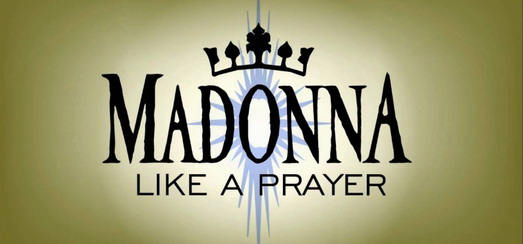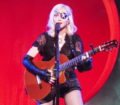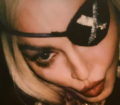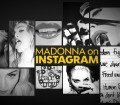
Madonna’s “Like A Prayer” album is celebrating its 25th Anniversary today!
To celebrate this, Billboard spoke with Patrick Leonard — the primary co-writer and co-producer of the set — to discuss the making of the album and his recollections of working with Madonna.
Check out this incredibly interesting article!
Billboard: When you were working with Madonna on the album, you had already worked with her on “True Blue” and “Who’s That Girl,” and you had worked with her on tour as the musical director for the Virgin Tour and the Who’s That Girl Tour. What was it about your working relationship that made it so successful? Clearly there was something very special between the two of you. Is there something tangible that you can actually name?
Patrick Leonard: The one thing would be that, in terms of musical spirits, like any good collaboration, we’re sort of on opposite ends of the spectrum, in terms of our approach to music.
I started playing the piano when I was three-years old, and studied music my whole life. It’s my language. And for her, it’s much more just about creativity, and a natural gift, what the impulse says is right.
So, that thing of, almost opposites makes nice chemistry. And it always did with us, because I could write something somewhat complicated and and somewhat complex — certainly especially in the pop realm — and she would respond collaboratively with something that anchored it in something very simple and central.
And when I say simple, I don’t mean stupid. I mean just not complicated. You know, simple in that beautiful way that when something is really simple, it’s not easy to do something simple. . . . When you look at most well-known collaborations over the decades of music that we’re familiar with, they’re always opposite types of people that are doing the best work. David Gilmour and Roger Waters. John Lennon and Paul McCartney. And I’m certainly not comparing Madonna and I to those people, but you know what I mean.
The other thing is that we’re both from Michigan. We’re both people that grew up in a place where it’s 30 below zero a good part of the year and blue collar work ethics apply to everything. I still am a blue collar work ethic type of person, and so is she. So we shut up and we did the work. We had this creative chemistry, and then there was no futzing around. There was no question about what the job was.
Billboard: Speaking of chemistry, there’s been a lot of rumors that you guys are going to work together on her next album. Is that even remotely true?
Patrick Leonard:I’ve gotten a bunch of people who have forwarded me a bunch of those emails (saying that they’ve) seen us in restaurants together. None of it’s true.
Leonard co-wrote and co-produced the bulk of the “Like a Prayer” album with Madonna, including hits like “Cherish” and “Oh Father.” Of the album’s 11 songs, Leonard co-created eight of them with the diva. The set has gone on to sell four million copies in the U.S., according to the Recording Industry Association of America.Billboard: You’ve said before that “Like a Prayer” was the first song that was written for the album. When you guys finished that song, or at least had it at some sort of stage where it seemed like it was finished, did know that you had something special?
Patrick Leonard: I think there was a point when we realized that it was the title track, and the lead track, and it was going to a powerhouse. It became obvious that there was something unique about it. And that somehow we made this thing work: with its stopping and starting, and a minimalistic rhythmic thing, and the verses, and these bombastic choruses, and this giant choir comes in. This is ambitious, you know?!
Of the songs I’ve worked on in the studio — which is in the thousands — there is something different when you write something and you just have a sense that you can’t break this, you can’t really ruin this. It exists already. And that used to be what made a hit song.
Billboard: I’m assuming you watched the Super Bowl when she performed “Like a Prayer”?
Patrick Leonard: No, I actually didn’t. . . I heard it was really cool! I think I might have seen a YouTube video or something of it afterward. You know, just to hear the song is really cool and to know that she’s still doing the songs — some of the songs that we wrote together — makes me happy. A lot of people were like all the rage about that — that she did that song. I’m just happy she’s still doing it. I think it’s great.
The “Like a Prayer” album proved to be very successful, spawning five top 20 hit singles on the Billboard Hot 100 chart: the title track (peaking at No. 1), “Express Yourself” (No. 2), “Cherish” (No. 2), “Oh Father” (No. 20) and “Keep It Together” (No. 8).
Billboard: Were there songs recorded for the album that the two of you worked on that eventually were just shelved or haven’t been released?
Patrick Leonard: I think there was one, but I’m not sure what it was a remnant of. It might have been a remnant of “Who’s That Girl” or of “I’m Breathless.” There was ever only one song, and it got released as a b-side, and I don’t remember what it was called, even. I don’t think it was “Like a Prayer”-era. [Note: Leonard may be referring to the “Cherish” b-side, “Supernatural.”] My recollection is that we just wrote the songs that were going on the record and that was it. I mean, those songs were written one a day — that’s it. A few hours and they were done.
Billboard: Prince turns up on the album, obviously, on “Love Song,” the song he’d and Madonna did together. I’ve read that his guitar work is on “Keep It Together” somewhere.
Patrick Leonard: What I know is that his guitar work is on, when you start “Like a Prayer,” the guitar that you hear before the door slams…
Billboard: The distorted guitar?
Patrick Leonard: That’s Prince. What happened is, [Madonna] sent him something to play on and he played on it and sent it back. And we didn’t feel that what he did served it. But that piece, that beginning, is him.
Recently, I listened to [the song “Like a Prayer”] — I hadn’t heard it years. There’s a heavy rock guitar that’s in the bridges — I don’t think it’s Prince. There’s a heavy guitar in the choruses and when I heard it, I thought: “Did we use his guitar in those bridges?” Because the sound is similar to the first sound [in the opening], but it’s not exactly the same. . . . But I know for a fact that we did use that [Prince] thing as the intro, because we just thought it was crazy and really cool. I seem to recall that that’s all we used, but I could be wrong.
Billboard: With “Oh Father,” were you surprised that song was chosen to be a single? That was a pretty bold move for her because it was such a slow, heavy song to come out as a big pop commercial single from her at the time.
Patrick Leonard: My favorite thing that we ever recorded, ever — or wrote — is “Oh Father.” That to me is the best thing we ever did, is “Oh Father.” So, it didn’t surprise me because we knew when we did it, that there was something about this that was in a way kind of the most *real* thing.
[For] that song, the ‘record’ button was only pressed three times. It was pressed to do the track, live, with her singing live. Then we did the orchestra. And then we did a double of her vocal when we were mixing. That’s it. So it’s real. It’s something that I really wanted to do and she was kind enough to say “let’s try this,” and it was not easy.
There’s two or three guitar players playing. I’m playing keyboards. Jai Winding was playing keyboards. There was a percussionist and a drummer — and she’s singing — all at the same time.
These days, people go “wow, that seems crazy.” Those days it wasn’t uncommon for everybody to be playing together even though you’re not a band. But it was one of those things where the arrangement was tricky enough, that it really took some working out to get it all right.
Even all those weird synth overdubs and things — all those things were being done live. We worked out all the parts, had all the sounds. I remember that we cut it live, and then put the orchestra on. You’re not doubling the orchestra, so it’s one pass for the orchestra.
When I say [the ‘record’ button was] pressed three times, it might have gotten pressed 10 [times] that day, but it was ultimately one that stayed there. If you see what I’m saying. When we were mixing it, [mixer] Bill Bottrell suggested that we double the choruses. I remember even being a little upset about it (Laughs). Like, look, “we’ve got an amazing record that we only pressed the record button twice — can’t we leave it?” He said, “three isn’t exactly shameful.” We doubled the lead vocal on the choruses, and that was it.
Billboard: The whole album sounded so “live” with real instruments. It didn’t sound computery or programmy, and I think that was surprising to a lot of people. Was there a focus to make it have more of a “live” sound?
Patrick Leonard: I’ve always had that agenda, at least it was then. I’ve actually kind of cooled on it a bit, because I’m not sure it matters that much when people don’t actually understand A) what they’re listening to or B) even how to play in an ensemble unless they’re 60-years old like I am. It’s not something people really do very well anymore.
It was one of those things I was always on my soap box saying “let’s get real musicians in.” And I think also that we had done the tour or even a couple tours I think at that point, and I was musical director on those tours, so we had the experience of working with live players. We had a couple players that were part of the flock that we knew we could bring in, and my studio is very well set up. It wasn’t in any way painful. It was fun and easy.
It was kind of a process of getting the songs written, and the demos recorded, which was just you know, me, by myself making the demos and her singing. And then replacing the drum machines and the percussion with real people and getting background singers in and having guitar players come in and do parts. Most of the bass on the record is synth-based. Most of it is me playing bass. But on a couple things, there’s bass players added. Like “Like a Prayer’s” Guy Pratt and me. I think “Express Yourself” is Randy Jackson playing bass.
Billboard: Was there something unique or special about including backup singers Donna De Lory and Niki Haris on the album? They also had worked with Madonna a lot on her previous tours. Was there something special about their sound that blended well with hers?
Patrick Leonard: Yeah, it was. When we were putting the [“Who’s That Girl”] tour together, I found Donna [because she] sang the demo for “Open Your Heart” and that’s how hear voice came to me. She sounded similar to Madonna, so, well, let’s get her in to sing something, because it’s going to blend really nice.
And Niki was somebody that someone recommended… She might have even just auditioned cold, I really don’t recall. But they were chosen from many many many people. And we worked on the road together. It was just natural.
Billboard: “Dear Jessie” was inspired by your daughter, Jessie, who was a toddler at the time. What does your daughter think of the song now?
Patrick Leonard: They hung out a bit, and she remembers a lot of that, even though she was very little. It wasn’t arbitrary — it was like they were kind of buddies. Jessie was tour with us when she was just a baby. We have a lot of photos of them together in the studio. My daughter is 28 now and she’s actually working for me as a writer and she’s just an amazing human being.
I think Jessie feels like that’s an interesting thing that she has out there, but I don’t think she considers it her legacy (laughs).
Billboard: No, no, I didn’t mean it like that! It’s kind of a fun curiosity to have this song that was written about and inspired by you.
Patrick Leonard: Every once in a while it comes up. Somebody will send her something, or say, “You’re the Jessie?” And she thinks it’s funny. It’s sweet. It was really sweet of Madonna to do that. Even that little video that they used — that animated video in the U.K. — was an animation based on a photo of Jessie. It doesn’t look anything like Jessie to me. But they wanted a photo of her for the video.
Billboard: When you and Madonna worked together, she would mostly do the lyrics and you would bring in the music. Was there overlap where you would suggest ideas for different lyrics, or she would suggest a change in the music?
Patrick Leonard: To my recollection‚ the norm was that I would go in the morning — you know, I’d get to the studio very early, 8 o’clock, 7 o’clock sometimes. I had a gym in the studio, I used to work out there. So by 8 o’clock or so, I was working. I like to start really early in the day. She would come in about 11 and I would have the musical idea on whatever piece of gear I was using. I think it was just a Yamaha sequencer or something at the time. Or we might have been up like to an MPC 60 or something like that.
I would just put the track, the chord changes, some kind of drum beat, bass line — something simple — and say, “here’s the idea, here’s what I have for the day.” She would listen, then we would talk a little bit. Oftentimes I’d say, “here’s the verse, and here’s the chorus,” and she’d say, “no, it’s the other way around, switch ’em.” So I’d switch ’em. This thing is an hour old, it’s not etched in stone.
Then she would just start writing. She’d start writing lyrics and oftentimes there was an implied melody. She would start with that and deviate from it. Or if there was nothing but a chord change, she’d make up a melody. But, a lot of the time in my writing there’s a melody implied or I even have something in mind. But she certainly doesn’t need that.
She would write the lyrics in an hour, the same amount of time it took me to write the music (laughs). And then she’d sing it. We’d do some harmonies, she’d sing some harmony parts, and usually by three or four in the afternoon, she was gone.
That’s how “Like a Prayer” was written, and then the next day we wrote “Cherish,” and then the next day we wrote “Dear Jessie.” And that’s how it was. We wrote the album in less than two weeks.
Billboard: You wrote the album in less than two weeks?
Patrick Leonard: Yeah. Because we wrote a song a day, and we didn’t change them. And oftentimes the vocal that she did was the lead vocal, we didn’t even change the lead vocal. That was it. She sang it. It was done.
We learned that from [her album] “True Blue”… “Live to Tell’s” [vocal] was a demo, and so were a lot of others. It’s not that they were demo vocals — they were just never sung more than once.
I put the track together, she would sing it, and that was it. We learned from that. This idea of a ritualistic vocal session doesn’t make any sense. You perform now. You know the song, perform it. And oftentimes, the energy that’s there because you’re in this creative space is much more pure than when you’ve thought about it and worked on it and practiced it in your car and all that stuff. It’s like, eh, come on. Blue collar, once again. Get to work (Laughs).
Patrick Leonard would continue to work with Madonna after “Like a Prayer.” He co-produced the bulk of her 1990 “I’m Breathless” album (including the cheeky top 10 Hot 100 single “Hanky Panky”) and co-wrote and co-produced her No. 2 smash “I’ll Remember” in 1994. He later worked with Madonna on her 1998 album “Ray Of Light,” including the No. 2 single “Frozen” and the top 20 hit “The Power of Good-bye.” He most recently collaborated with Madonna in 2008. He composed the music for her documentary film “I Am Because We Are.”
Billboard: Would you like to work with Madonna again?
Patrick Leonard: I would love to, because it’s always really musically satisfying. We’ve done some things — little things — over the years. But the record-making/sitting down and writing songs together, we haven’t done it in ages.
There was a musical play that she was considering and we got together and worked on some music, and we wrote a couple songs from scratch. And there was one ballad, and I remember the day we did it.
I had written the music and she wrote the lyrics and went in and sang it. And she came out of the booth and we both kind of looked at each other and she said, “You know, I think some things never change.” It was just an immediately great song.
You know, my music, her words, her voice. There’s a chemistry that’s really cool. I would love to [work with her]. But I also deeply respect her trajectory, and we’re on very different trajectories. I’m very happy right now working with my monk (Cohen). With this beautiful old monk who’s just probably the greatest poet on earth. Makes me really happy.
Madame X is available in Box Set, CD, Vinyl and Cassette!
Get your copy HERE!





